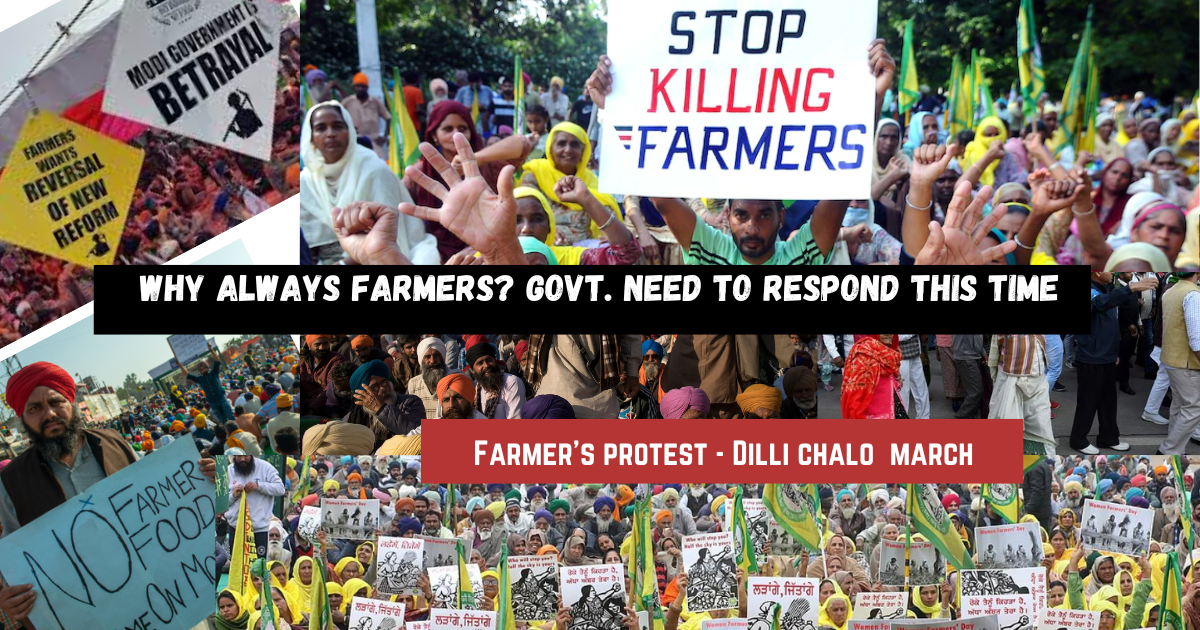The Ongoing Farmer Protests: Demands and concern
The farmer protests in Punjab and Haryana have garnered attention once again as farmers gear up for a ‘Dilli Chalo’ march. This blog explores the demands of the farmers, the response from the government, and the factors influencing the current protests.
Demands of the Farmers:
- The primary demand of the farmers is the enactment of a law to guarantee Minimum Support Price (MSP) for crops.
- Other demands include the implementation of the Swaminathan Commission’s recommendations, pension for farmers and farm laborers, farm debt waiver, withdrawal of police cases, and justice for victims of violence.
These demands raise during the time of 2020 3 farmer bill which now repealed by govt. marked as a massive failure on the side if govt.
Recommendations of Swaminathan report: (2006)
Under the chairmanship of M.S Swaminathan the committee was created in 2oo4 submitted its report in 2006- regarding farmers and their issue whose recommendation never implemented but in ongoing protest farmers are demanding the implementation of following recommendation let’s have a look on those recommendations for a clear understanding:
- Price Support and MSP: The commission recommended ensuring a minimum support price (MSP) for agricultural produce to guarantee farmers a fair income for their crops. It suggested MSP should be fixed at least 50% more than the total cost of production, taking into account factors like input costs, labor, and land rent.
- Credit and Insurance: The report emphasized the need for timely and adequate credit facilities for farmers, especially small and marginal farmers, to meet their production expenses. It also called for the expansion of crop insurance schemes to end the risks associated with crop failure and natural disasters.
- Land Reforms: The commission highlighted the importance of land reforms to address issues of landlessness, tenancy, and unequal distribution of land. It recommended measures such as land redistribution, consolidation of fragmented land holdings, and protection of farmers’ land rights.
- Water Management: Recognizing the significance of water management in agriculture, the report proposed strategies for efficient utilization of water resources, including rainwater harvesting, watershed management, and promotion of water-saving irrigation techniques.
- Crop Diversification and Sustainable Agriculture: To enhance agricultural sustainability and resilience, the commission advocated for crop diversification, promotion of organic farming practices, and conservation of soil health and biodiversity.
- Technology Adoption: The report stressed the importance of adopting modern agricultural technologies and practices to increase productivity and reduce production costs. It recommended investment in research and development, extension services, and farmer education programs.
- Market Reforms: Addressing issues related to market access and agricultural marketing, the commission proposed measures to strengthen agricultural marketing infrastructure, facilitate direct market access for farmers, and promote farmer-producer organizations.
- Social Security and Welfare: Recognizing the vulnerability of farmers to economic uncertainties and social challenges, the report recommended the provision of social security measures, including health insurance, pension schemes, and access to basic amenities like education and healthcare.
Overall, the Swaminathan Commission’s recommendations aimed to address the multifaceted challenges faced by farmers in India and promote sustainable and inclusive agricultural development.
Current Mobilization Efforts:
- In following Farmer Protest -Farmer organizations in Punjab and Haryana are mobilizing support for the ‘Dilli Chalo’ march.
- Over 200 farmers’ unions from across the country are expected to participate, led by organizations like the Samyukta Kisan Morcha and the Kisan Mazdoor Morcha.
Response from Farmer Leaders and Organizations:
- While some farmer leaders are actively supporting the protests, others have expressed reservations.
- The Samyukta Kisan Morcha, a key organization in previous protests, is not actively backing the current mobilization.
- Khap panchayats, particularly those representing the Jat community, are reportedly less keen on supporting the protests this time.
Political Dynamics:
- Speculation surrounds the potential alliance between the Rashtriya Lok Dal (RLD) and the BJP in Uttar Pradesh, which could impact farmer participation in the protests.
- The stance of prominent leaders like Rakesh Tikait remains unclear, adding to the uncertainty surrounding the protests.
Government’s Response and Security Measures:
- The government has engaged in talks with farmer leaders, with Punjab Chief Minister Bhagwant Mann mediating discussions.
- Despite ongoing negotiations, farmers remain determined to proceed with the ‘Dilli Chalo’ march on February 13.
- In anticipation of the protests, heavy security arrangements have been put in place, with warnings issued to farmers against participating without permission.
Conclusion:
- The current farmer protests reflect ongoing tensions between agricultural stakeholders and the government.
- While demands for MSP and other reforms persist, internal divisions among farmer organizations and political dynamics add complexity to the situation.
- As both sides navigate negotiations and security concerns, the outcome of the ‘Dilli Chalo’ march remains uncertain, with implications for the future of agricultural policy and farmer-government relations.
